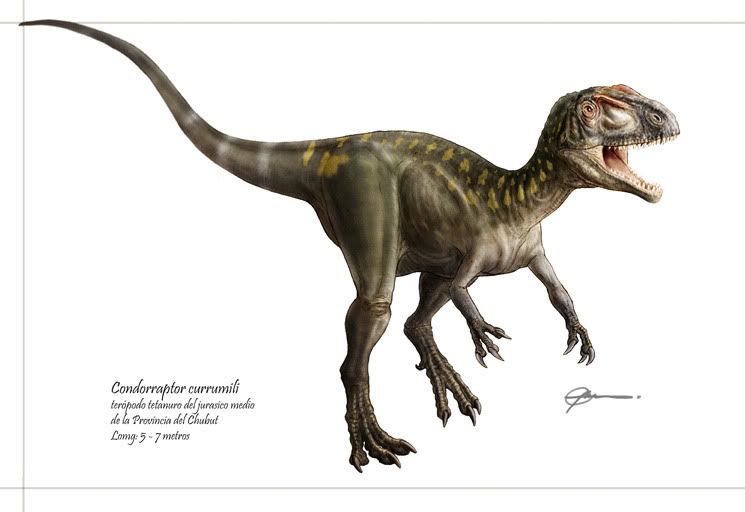Post by creature386 on Feb 13, 2013 1:02:25 GMT 5
Condorraptor currumili

Temporal range: Middle Jurassic (Bajocian to Callovian)[1]
Scientific classification
Kingdom:Animalia
Phylum:Chordata
Class:Sauropsida
Order:Saurischia
Suborder:Theropoda
(unranked):Tetanurae
Superfamily:Megalosauroidea
Genus:Condorraptor
Species: Condorraptor currumili[1]

Image from: [1]
Summary (from wikipedia, posted here by Taipan, slightly edited by me):
Condorraptor (meaning 'robber or snatcher from Cerro Condor) is a genus of megalosauroid theropod dinosaur. It lived during the Middle Jurassic in what is now Argentina, Canadon Asfalto Formation. The type species, described in 2005, is Condorraptor currumili. It is based on a tibia, with an associated partial skeleton that may belong to the same individual. Initially described as a basal tetanuran, Benson (2009) found it to be a megalosauroid and the sister taxon of Piatnitzkysaurus.
Location: Las Chacritas, 2.3 km west of Cerro C´ondor, Chubut, Argentina; Ca˜nad´on Asfalto Formation, Sierra de Olte Group; Bajocian–Callovian, Middle Jurassic (Rauhut 2005a; Volkheimer et al. 2008).[1]
Description:
Condorraptor currumili (meaning 'robber or snatcher from Cerro Condor) was a medium sized theropod, described by Rauhut (2005), from the middle jurassic of argentina, known from a couple of specimen (it are 1 holotype and 31 paratypes). The holotype (MPEF-PV 1672) is only known from a left tibia, with a highly abraded proximal end and a pedal phalanx, what could be a bone from the holotype. The paratypes are MPEF-PV 1673–1697 and MPEF-PV 1700–1705[1], these are known trough cervical vertebrae, ribs, leg parts (including femora), parts of the pubis (like the illum) and vertebae.[3]
According to Rauhut, they all belong to a mid-sized theropod and could belong to the same specimen, due to the multiple specimen, he also considered it as the 2. best known theropod from the middle Jurassic of Gondwana and he believes it supports his theory of a radiation of theropods in the upper triassic to the lower jurassic.[2]
Classification:
This theropod can be identified by the pleurocoel location and the depressions on it's tibia (Rauhut 2005). Rauhut has found features in the Holotype, which are compareable to other theropods, so he classified it as one[2]. Overall, it is compareable to Piatnitzkysaurus, but Condorraptor currumili still has enough features to be called a distinct species, like it having an incision between the femur and tibia[2][1]. Also, some features Megalosaurus and Piatnitzkysaurus (Benson 2009)[4] can't be found in Condorraptor currumili[1].
Sources:
[1] M. T. Carrano, R. B. J. Benson, S. D. Sampson: The phylogeny of Tetanurae (Dinosauria: Theropoda). In: Journal of Systematic Palaeontology. 10, Nr. 2, 2012, S. 233
[2] Rauhut, O. W. M. 2005. Osteology and relationships of a new theropod dinosaur from the Middle Jurassic of Patagonia. Palaeontology, 48, 87–110. onlinelibrary.wiley.com/doi/10.1111/j.1475-4983.2004.00436.x/abstract
[3] archosaur.us/theropoddatabase/Megalosauroidea.htm#Condorraptorcurrumili
[4] Benson, R. B. J. 2009. An assessment of variability in dinosaur remains from the Bathonian (Middle Jurassic) of Stonesfield and New Park Quarry, UK and taxonomic implications for Megalosaurus bucklandii and Iliosuchus incognitus. Palaeontology, 54, 857–877.

Temporal range: Middle Jurassic (Bajocian to Callovian)[1]
Scientific classification
Kingdom:Animalia
Phylum:Chordata
Class:Sauropsida
Order:Saurischia
Suborder:Theropoda
(unranked):Tetanurae
Superfamily:Megalosauroidea
Genus:Condorraptor
Species: Condorraptor currumili[1]

Image from: [1]
Summary (from wikipedia, posted here by Taipan, slightly edited by me):
Condorraptor (meaning 'robber or snatcher from Cerro Condor) is a genus of megalosauroid theropod dinosaur. It lived during the Middle Jurassic in what is now Argentina, Canadon Asfalto Formation. The type species, described in 2005, is Condorraptor currumili. It is based on a tibia, with an associated partial skeleton that may belong to the same individual. Initially described as a basal tetanuran, Benson (2009) found it to be a megalosauroid and the sister taxon of Piatnitzkysaurus.
Location: Las Chacritas, 2.3 km west of Cerro C´ondor, Chubut, Argentina; Ca˜nad´on Asfalto Formation, Sierra de Olte Group; Bajocian–Callovian, Middle Jurassic (Rauhut 2005a; Volkheimer et al. 2008).[1]
Description:
Condorraptor currumili (meaning 'robber or snatcher from Cerro Condor) was a medium sized theropod, described by Rauhut (2005), from the middle jurassic of argentina, known from a couple of specimen (it are 1 holotype and 31 paratypes). The holotype (MPEF-PV 1672) is only known from a left tibia, with a highly abraded proximal end and a pedal phalanx, what could be a bone from the holotype. The paratypes are MPEF-PV 1673–1697 and MPEF-PV 1700–1705[1], these are known trough cervical vertebrae, ribs, leg parts (including femora), parts of the pubis (like the illum) and vertebae.[3]
According to Rauhut, they all belong to a mid-sized theropod and could belong to the same specimen, due to the multiple specimen, he also considered it as the 2. best known theropod from the middle Jurassic of Gondwana and he believes it supports his theory of a radiation of theropods in the upper triassic to the lower jurassic.[2]
Classification:
This theropod can be identified by the pleurocoel location and the depressions on it's tibia (Rauhut 2005). Rauhut has found features in the Holotype, which are compareable to other theropods, so he classified it as one[2]. Overall, it is compareable to Piatnitzkysaurus, but Condorraptor currumili still has enough features to be called a distinct species, like it having an incision between the femur and tibia[2][1]. Also, some features Megalosaurus and Piatnitzkysaurus (Benson 2009)[4] can't be found in Condorraptor currumili[1].
Sources:
[1] M. T. Carrano, R. B. J. Benson, S. D. Sampson: The phylogeny of Tetanurae (Dinosauria: Theropoda). In: Journal of Systematic Palaeontology. 10, Nr. 2, 2012, S. 233
[2] Rauhut, O. W. M. 2005. Osteology and relationships of a new theropod dinosaur from the Middle Jurassic of Patagonia. Palaeontology, 48, 87–110. onlinelibrary.wiley.com/doi/10.1111/j.1475-4983.2004.00436.x/abstract
[3] archosaur.us/theropoddatabase/Megalosauroidea.htm#Condorraptorcurrumili
[4] Benson, R. B. J. 2009. An assessment of variability in dinosaur remains from the Bathonian (Middle Jurassic) of Stonesfield and New Park Quarry, UK and taxonomic implications for Megalosaurus bucklandii and Iliosuchus incognitus. Palaeontology, 54, 857–877.


